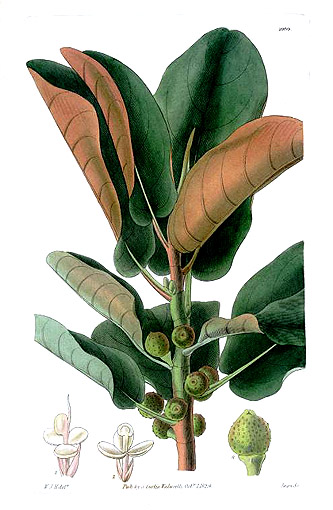
Ficus rubiginosa Desf. ex Vent.
"A small tree in our stoves" begins the description in Curtis's Botanical Magazine. This is a monster at Monserrate. The description continues more true to form "throwing out many, spreading branches, and from the the stem and branches numerous woody roots, which reach the ground, like those of the famous Banyan, and give new support to those parts. Introduced by the Right Hon. Sir Joseph Banks, from New South Wales to the Royal gardens, whence it has been distributed, and is , we believe, now general in collections of stove plants. Its frutification is, however, of rare occurance. The specimen from which the accompanying figure was taken was sent by the Messrs. SHEPHERD, from the Liverpool Garden, in the summer of 1827."
Ficus rubiginosa occurs from north Queensland southwards along the eastern coastline of Australia to the vicinity of Bega on the South Coast of New South Wales. It is found on the edges of rainforest and gullies and rocky hillsides. (Wikipedia)
There has been some confusion over the naming of this fig with Ficus macrophylla, a related though far larger tree that lacks aerial roots and the rusty indumentum. Ficus macrophylla in Southern Europe is often designated Ficus magnolioides Borzi (invalid synonym of Ficus macrocarpa subsp. columnaris). It is easy to see why Ficus magnolioides should be transferred to Ficus rubiginosa trees in error - to the unwary the large glossy leaves and rusty undersides of Ficus rubiginosa do look somewhat like a Magnolia .
There is a magnificent specimen of Ficus macrophylla subsp. columnaris at the Palermo Botanic garden It was planted in 1845 by Vincenzo Tineo (1791-1856). He was director of the Orto botanico di Palermo from 1814 until 1856. The tree was brought from Norfolk Island. This was Borzi's type specimen for his Ficus magnolioides.



No comments:
Post a Comment